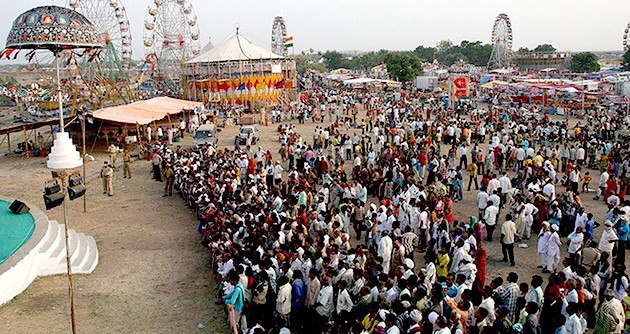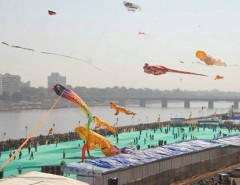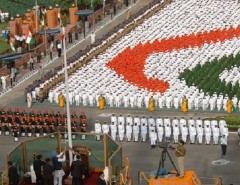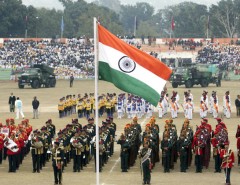The Tarnetar Fair, also known as the Trinetreshwar Mahadev Fair is held at Tarnetar, near the industrial town of Thangadh, Saurashtra. This fair is one of the most important fair of Gujarat. The local as well as the tribal people gather from all over Gujarat to participate in the various activities that take place at the fair. It is believed that the fair is held on this ancient site since antiquity. The fair is also one of the most important matchmaking melas as the tribal youths visit Tarnetar to find a suitable match. Its association with the Mahabharat is underlined by the fact that the area was known as Panchal Pradesh, the land to which Draupadi belonged. The fair is linked with the story of Draupadi’s Swayamvar and it is said that it was at this place that the great archer Arjuna performed the difficult task that won him his bride. Over 300 stalls are set up in the fair, that sell numerous objects and offer various types of food and refreshments. There are exhibitions of embroidery, a cattle show, competitive sports, family planning stall, merry-go-rounds and photographer’s stall. The folk music and dances like the Garba ras and hodo are the main features of the fair.
The fair is organised in Tarnetar village some 39 kilometres from Chotila in Surendranagar District in Gujarat. It is popularly known as the Trinetreshwar Mahadev Mela and revolves around the sacred temple of Trinetreshwar.
It is held during the first week of Bhadrapad (September-October). This fair is primarily a ‘marriage mart’ or ‘Swayamvar’ for the tribal youth who visit Tarnetar to find a suitable bride for themselves. The fair is held around the Trinetreshwar Temple dedicated to the three-eyed Lord Shiva, built at the beginning of the century. There is a kund (reservoir) here and it is popularly believed that a dip in its waters is as holy as a dip in the sacred River Ganges. The reservoir is also known as papanshu (the destroyer of sins).
The region is also of mythological significance. It is known as the Panchal region, the native place of Draupadi. According to folklore, it was here that Arjuna accomplished the difficult task of piercing the eye of a fish, rotating at the end of a pole, by looking at its reflection in the pond water. The swayamvar was also held around the pond in Tarnetar. Even now, the tradition of swayamvar has survived and unmarried men and women from the Bharwad and other tribal community visit the fair in search of a match, attired in their traditional clothes. Men stand under exquisitely embroidered umbrellas signifying their marital status while women go around the umbrella hunting for their grooms.
Cattle exhibition is an attraction for the tourists with other programmes like ‘Rural Olympics’, bullock cart race and horse race is held at Tarnetar. Local arts and crafts display is an added trade attraction. The tourists have an opportunity to learn the folk dances like the Hudo and Raas dance of the Maladhari community. Heritage monuments are a sight seeing attraction at the venue place. Tarnetar Fair venue provides accommodation in tents and kuba houses for the tourists.
A mix blend of culture, tradition and social extravaganza, the Tarnetar Fair has gained popularity with more foreign tourists visiting the place.
Rabari women of nearby Zalawad perform the famous circular folk dance called rahado. Their marital status is indicated clearly by their costumes; a black zimi (skirt) means she is married. But if a woman is wearing a red zimi, it means she has not yet tied the knot, probably seeking a husband. The potential husbands seeking brides are elegantly dressed in colorful dhotis, artistically designed waistcoats and a head-cloth twisted at an angle, moving about the fairground at Tarnetar with striking umbrellas, advertising the bachelorhood they are keen to relinquish.
The Tarnetar Mela covers a large part of the Tarnetar village with a huge number of stalls put up to sell beautiful local handicrafts unavailable elsewhere, along with ethnic jewelery, statues of deities and traditional attire with tiny mirrors embroidered into the clothing. There are also merry-go-round rides, photographers stalls, magic shows and tattoo artists who attract a large variety of visitors.
History
Legend says that this fair has been held here since antiquity. Its origin is linked with the story of Draupadi’s swayamvar, where the great archer Arjun performed the difficult task of piercing the eye of a rotating fish with an arrow, by only looking at its reflection in the water. Through this feat he won his bride Draupadi.
Historically speaking, this festival tradition is believed to have begun 200-250 years ago. The fair is held on the grounds of the temple of Triniteshwar Mahadev, which means “the three-eyed God.” The old temple that used to stand in Tarnetar was ruined, but a new one was built by the Gaekwads of Vadodara in the 19th century, and is now the focal point of the festival. It stands on the bank of a rivulet and opens into a beautiful kund. It is locally believed that this site used to be the original course of the Ganga river at some point in history, so a dip in the temple tank is considered by pilgrims to be as auspicious as a swim in the holy Ganga.
Interesting facts
The Kolis of Saurashtra initiated the custom of embroidering umbrellas, which are exquisitely elaborate in terms of embellishments. The embroidery of each is unique and rises from the edges all the way to the top, with beadwork and patchwork in the design as well. Small colorful handkerchiefs are attached all around the edge, to attract further attention. These men spend over a year embroidering their umbrellas. Their intention is to entice the girls with their art, cloths and head gear and impress them, so that they can propose them for marriage. It is not surprising that, before the fair is over, they usually meet the lady of their choice.
Nearby destinations
Tarnetar is close to the town of Surendranagar, 59 kms away. Rajkot is 75 kms and Jamnagar is about 162 kms away. It is also not difficult to plan a journey to Kutch from here.




